As Britain prepares for a referendum on its EU membership, the issue of what it means to inhabit an independent nation has been brought to the fore. This coincides with a rise in nationalism across Europe, which in turn has led to the increasing prominence of the symbols associated with identity, whether they be spoken, written or visual. In times of relative instability, the mechanisms of power – which are themselves in constant movement – are revealed. In the process, the similarity between power statements and artistic statements also becomes clear, as the status of a nation or region is backed up by utterances and images used to underline the credibility of a given claim to power or sovereignty. Put simply, the statements ‘this is a nation’, ‘this is a government’ or ‘this is a legal currency’ are similar to the statement ‘this is art’ or ‘this is a landscape’. Both the political declaration and the artistic declaration depend on an original founding statement and on the acquiescence of the public to that statement. This is achieved with the support of other actors who back up the original declaration. In the case of the creation and maintenance of nation-states, these actors include a judiciary, a police force, a civil service, a national bank and, crucially, an army. The affirmation that some- thing is ‘art’ depends, similarly, on the support of critics, curators, art historians, collectors, gallerists and dealers. What this tells us is that neither the definition of a given territory or object as a nation-state or artwork is immutable. Both statements require constant reaffirmation and maintenance as boundaries and tastes shift.
Clearly the relationship between statecraft and art production is not parallel: the nation-state can exert a powerful influence over art production via its governmental representatives and its legal apparatus, while the politically engaged artist can do little to challenge or destabilise state power. However, art can mimic the processes of power, thereby throwing them into question. In this light, Spanish artist Santiago Sierra appropriated the image of the flag as a symbol of individual national sovereignty by hoisting two black flags at, respectively, the North Pole, on 13–14 April 2015, and South Pole, on 14 December 2015 (the anniversary of the day that Norwegian Roald Amundsen arrived at the South Pole in 1911, weeks before the ill-fated Robert Falcon Scott ‘of the Antarctic’). This logistically tough project – which was entitled Black Flag (Part 1 and Part 2) and required the cooperation of international scientists to make the expeditions possible – serves to underline the transient nature of the nation-state, which is arbitrary and manmade. The black flag itself is the symbol of anarchism, a system of thought resistant to centralised power. Being an anarchist symbol negates national interest by exactly the same mechanism that national flags, currencies, monuments and ceremonies aim to reinforce it. Yet, further, undertaken as an art statement, such a gesture exposes the mechanisms of state power as being no more solid or enduring than the artist’s declaration. This occurs as the nature of artmaking is seen to be the same in essence as the processes that contribute to the making of nation-states.
The placing of the flags at the two poles serves to negate the symbolism of the national flag and is particularly significant due to the specific political arrangements used to govern the Arctic and Antarctic. The former, being composed completely of ice, is considered part of the high seas and is accordingly divided among the neighbouring countries: Canada, Norway, Russia, Denmark (which governs Greenland) and the United States. The latter is governed by the terms of the Antarctic Treaty, which was signed by 12 nations in 1959, came into effect in 1961 and now has 53 signatories. The treaty, which is similar in form to a national constitution, stipulates, among other things, that: ‘Antarctica shall be used for peaceful purposes only (Art I)’ and that, ‘Scientific observations and results from Antarctica shall be exchanged and made freely available (Art III).’ Sierra’s artwork revisits the spirit of that treaty, which recognises, however unwittingly, the fact that the world need not be divided into competitive nations, but could instead be shared for the common good.
This article first appeared in the April 2016 issue of ArtReview.
